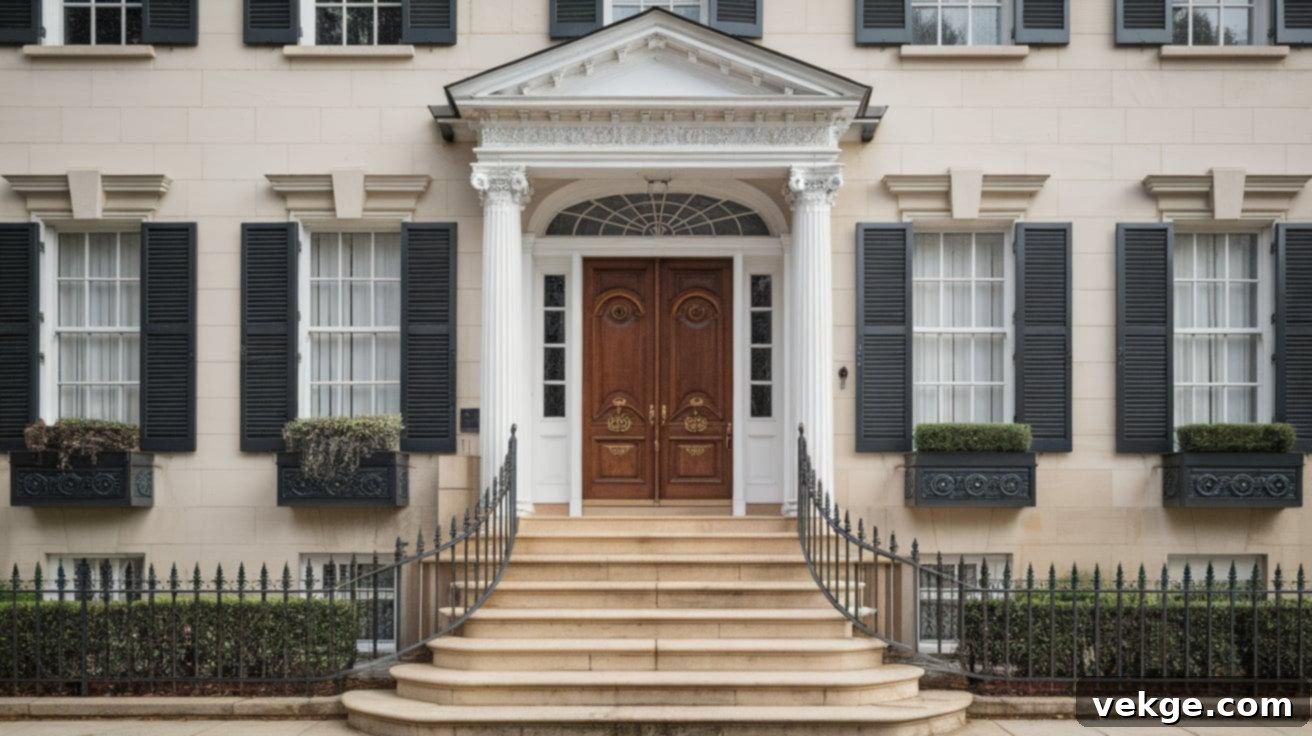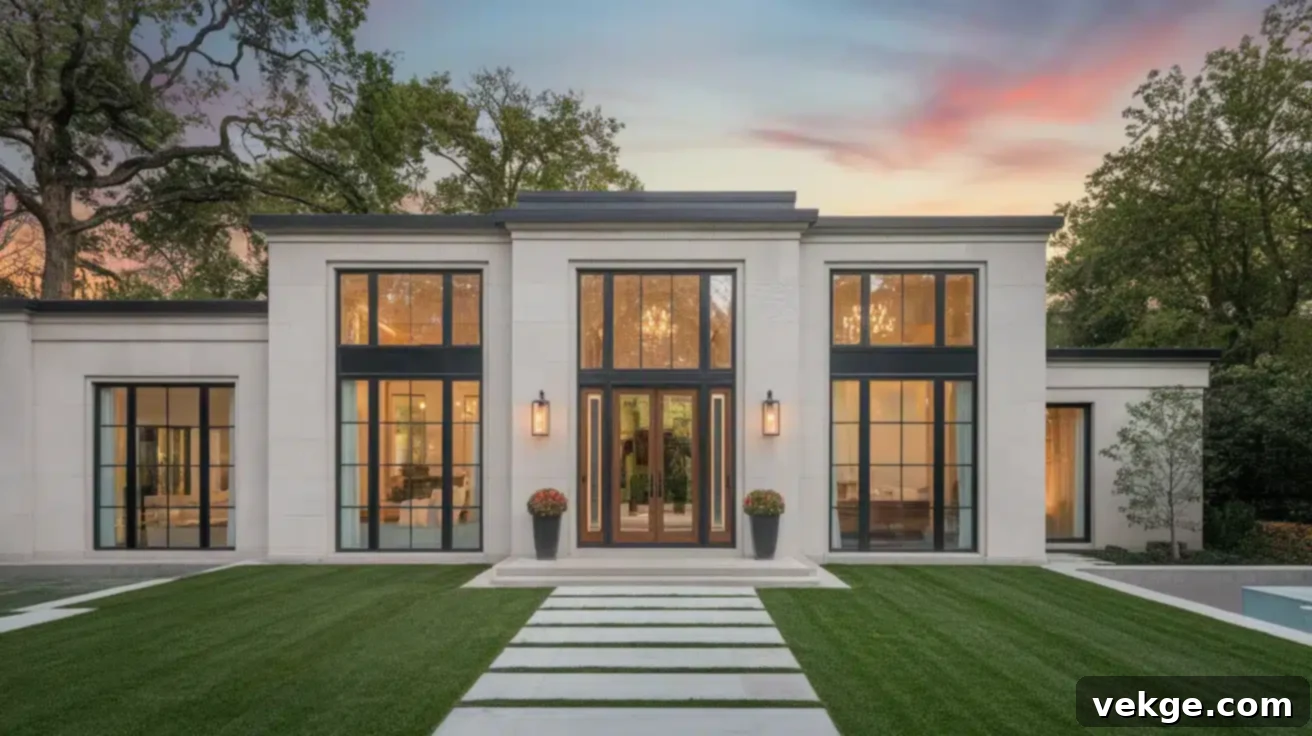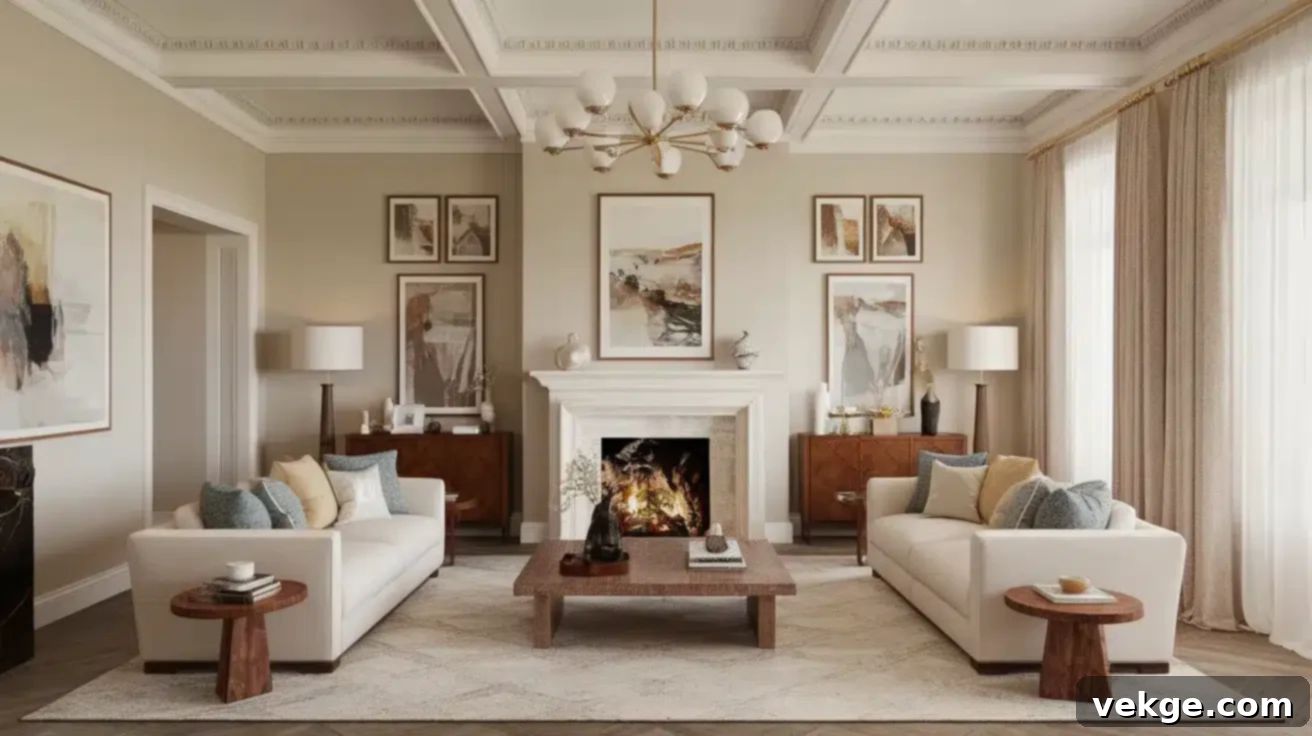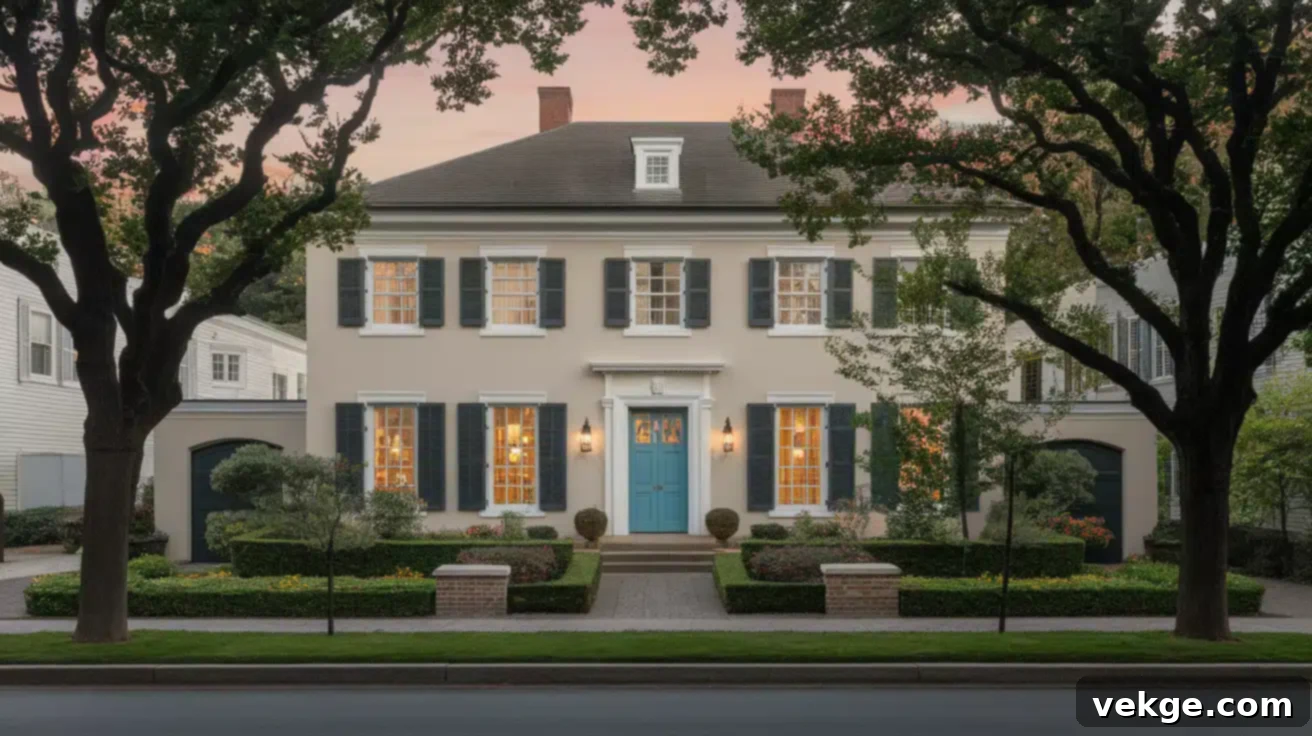The Enduring Elegance of Georgian Homes: A Timeless Architectural Style Guide
Searching for a home style that perfectly blends classic grandeur with inviting comfort? Georgian homes undoubtedly offer this unique combination. Originating from the 18th and early 19th centuries, these distinctive buildings continue to captivate us with their hallmark balanced design, understated beauty, and a profound sense of order.
Named after the successive British monarchs, King George I through IV, this influential architectural style first flourished in England before making its significant mark across the Atlantic in the American colonies. It brought with it a sophisticated aesthetic characterized by harmony and proportion, which remains highly sought after today.
In this comprehensive guide, we will journey through what makes Georgian homes so remarkable. We’ll explore their fascinating history and evolution, delve into the specific architectural features that define them, and understand why their appeal has not only endured but continues to inspire modern design and restoration efforts. Prepare to discover the secrets behind this enduring style and envision how its timeless charm might enhance your own living space.
The Rich History and Enduring Origins of Georgian-Style Houses
Georgian architecture stands as a testament to the prevailing building philosophies of the 18th and early 19th centuries. This iconic style, spanning roughly from 1714 to 1830, derives its name from the four King Georges who reigned over Great Britain during this period, leaving an indelible mark on the nation’s aesthetic landscape. It represents an era when classical ideals were reinterpreted for a new generation, emphasizing rationality, order, and a dignified sense of beauty.
Let’s explore the trajectory of this style, from its sophisticated beginnings in England to its adaptive transplantation across the burgeoning American colonies, shaping the architectural identity of entire regions.
Georgian Architecture in England: A Classical Revival
The dawn of Georgian architecture in England coincided with King George I’s ascension to the throne in 1714. This period witnessed a strong rejection of the elaborate Baroque styles that preceded it, in favor of a more restrained, yet equally impressive, aesthetic. Influenced heavily by the works of the Renaissance architect Andrea Palladio and the classical forms of ancient Greece and Rome, English Georgian homes embraced clean lines, strict symmetry, and harmonious proportions.
These residences, often constructed for the burgeoning upper and middle classes, conveyed an air of prosperity, education, and social standing. Rather than ostentatious display, Georgian homes in England exuded a quiet sophistication, reflecting the owners’ appreciation for culture and classical principles. Common materials included rich red brick, often laid in Flemish or header bond patterns, and elegant pale stone, giving these structures a solid, permanent quality that still resonates today.
Georgian Architecture in the American Colonies: Adaptation and Identity
As British influence expanded across the Atlantic, so too did its architectural traditions. Georgian homes began to appear in the American colonies from approximately 1700 to 1800, adapting to new environments and resource availability. American builders faced the challenge of translating a style often built with stone and brick in England, into a context where local timber was far more abundant.
Consequently, American Georgian homes frequently featured wooden construction, sometimes mimicking brickwork through painted clapboard or even stucco scored to resemble stone. Despite these material adaptations and a often simpler execution due to fewer highly skilled craftsmen, the core principles of symmetry, classical detailing, and a dignified presence remained intact. From the grand brick estates of Virginia to the more modest, yet perfectly proportioned, timber homes of New England, the Georgian style helped to solidify a sense of establishment and stability within the colonies, signaling a burgeoning new identity rooted in European tradition but distinctly American in its practicality and ingenuity.
Key Architectural Features Defining Georgian-Style Homes

When encountering a Georgian home, certain characteristic features immediately capture the eye, setting them apart with an unmistakable elegance. These residences possess a unique visual language that communicates both grandeur and an approachable warmth, a balance achieved through deliberate design choices that have stood the test of time. Let’s explore the fundamental elements that give Georgian architecture its distinct and enduring appeal, making these homes simultaneously imposing and inviting.
Symmetry and Proportions: The Heart of Georgian Design
At the core of Georgian architecture lies an unwavering commitment to balance and order. A defining characteristic is the perfect symmetry evident across the façade. Imagine a vertical line drawn down the exact center of the front elevation: each side mirrors the other with meticulous precision. Windows are not only aligned neatly but are also often evenly spaced, while the main entrance typically occupies the central position, acting as a focal point.
This deliberate use of symmetry was often guided by mathematical principles, including variations of the Golden Ratio, ensuring that every element contributed to a visually pleasing and harmonious composition. The result is a calming effect on the viewer, a sense of rightness and stability that transcends mere aesthetic appeal. This thoughtful proportionality extends beyond the façade, often influencing the layout of rooms within, creating a logical and serene living environment.
Exteriors and Materials: Regional Adaptations and Enduring Quality
The external appearance of Georgian homes, while always adhering to classical principles, often reflected the availability of local building materials. In England, the prevalence of rich red brick and various types of durable stone led to their widespread use. These materials not only offered longevity but also contributed to the dignified aesthetic. Brickwork was often executed with high skill, featuring intricate bonds and detailing.
Roofs were typically simple and functional, predominantly either hipped (sloping equally on all four sides to meet at a ridge) or gabled (sloping on two sides). A distinguishing feature of Georgian windows is the sash window, designed to slide vertically. These often comprised multiple small glass panes (known as glazing bars or muntins) within each sash, which were not only aesthetically pleasing but also a practical solution given the limitations of glass manufacturing at the time. These windows allowed ample natural light while providing reasonable insulation, contributing to both the beauty and comfort of the interiors.
Decorative Elements: Refined Details and Classical Accents
While known for its overall simplicity, Georgian architecture does not shy away from refined decorative touches, particularly around focal points. The front door often serves as the home’s primary architectural statement. It is frequently adorned with elaborate carved wood surrounds, sometimes featuring engaged columns or pilasters, and topped with a decorative half-circle or elliptical window known as a fanlight, which not only adds elegance but also allows light into the entryway. A pediment, a triangular or segmental shape above the door, is another common classical flourish.
Further decorative elements include intricate cornices (molding along the top of the walls, often at the roofline), which provide a sense of finish and classical grandeur. Flat, decorative columns called pilasters are sometimes pressed against the walls, offering a classical architectural detail without the structural demand of full columns. Quoins, often distinctively colored or textured stone or brick blocks, are frequently seen at the corners of buildings, emphasizing their solidity and adding visual interest. These carefully considered details add layers of class and sophistication without ever appearing overly ornate or ostentatious, embodying the Georgian ideal of elegant restraint.
The Modern Georgian Revival: Blending Timeless Style with Contemporary Living

The enduring appeal of Georgian style ensures its continuous revival. Today’s homeowners and designers are increasingly drawn to these classic designs, seeking the inherent elegance and balanced proportions, but with the added convenience and functionality of modern comforts. This resurgence highlights the style’s remarkable adaptability, proving that timeless aesthetics can seamlessly integrate with contemporary lifestyles. We are witnessing a captivating trend where builders and renovators are expertly marrying old-world charm with new-world practicality, creating homes that feel both deeply rooted in history and refreshingly current.
How Georgian Architecture is Being Adapted for Today’s Lifestyles
Modern Georgian-inspired homes masterfully retain the iconic symmetrical facades and dignified presence that are characteristic of the original style. However, a step inside reveals thoughtfully reconfigured spaces that cater directly to the demands of contemporary family living. Gone are the rigidly compartmentalized rooms of the past; instead, kitchens are often significantly larger, open-plan, and designed as the true heart of the home, perfect for entertaining and family gatherings. Walls that once created separation are now often removed to foster a more fluid and connected flow between living areas, encouraging interaction and shared experiences.
While the exterior maintains its classical integrity, the interior boasts all the advantages of modern technology and construction. Smart home systems are subtly integrated, often hidden behind period-appropriate moldings and architectural details. Energy-efficient windows are meticulously designed to replicate the multi-pane aesthetics of the originals, providing both historical accuracy and environmental benefits. Today’s builders exhibit a profound respect for the historical legacy of Georgian design, carefully preserving its beloved balanced aesthetics and beautiful proportions, while intelligently addressing and improving upon the functional limitations of the past, such as smaller kitchens and less flexible layouts. This harmonious blend ensures that modern Georgian homes offer the best of both worlds: classical beauty with unparalleled contemporary comfort and efficiency.
Decorating and Restoring Georgian Interiors: A Guide to Timeless Elegance

Stepping into a well-designed Georgian interior can feel like a serene journey through time, yet it simultaneously offers all the essential comforts and conveniences of modern life. These spaces possess a unique ambiance—a captivating blend of grandeur and intimacy, sophistication and practicality. If you are fortunate enough to inhabit a Georgian home, or simply wish to infuse your current residence with this distinguished style, understanding the principles of Georgian interior design is key. Here are some invaluable tips to help you cultivate that distinct Georgian magic within your walls, creating an atmosphere that is both historically resonant and wonderfully livable.
Proportional Design and Simplicity: Cultivating Calm and Balance
The inherent appeal of Georgian rooms stems from their meticulously considered proportions. These spaces adhere to classical rules regarding height, width, and length, creating an innate sense of harmony that is deeply satisfying to the eye. To replicate this feeling, prioritize an uncluttered and open aesthetic. Overcrowding a room with too many items can detract from its architectural beauty and disrupt its tranquil atmosphere. Instead, opt for fewer, carefully selected pieces of furniture that are well-made and strategically placed.
The goal is to evoke a sense of calm and order upon entering the room. This can be achieved by embracing simplicity, allowing the architectural features to shine, and emphasizing quality over sheer quantity. Each piece should contribute to the overall balance, ensuring that the room feels both spacious and inviting without being sparse. This mindful approach to furnishing and layout is fundamental to achieving the authentic, soothing feel of a Georgian interior.
Color Palettes and Decorative Styles: Beyond the Monochromatic Myth
A common misconception is that Georgian homes were exclusively adorned with stark white walls. In reality, the early Georgian period embraced rich and saturated hues, featuring deep reds, emerald greens, and vibrant blues that added warmth and depth to rooms. As the style evolved, particularly in the later Georgian and Regency periods, a shift towards softer, more delicate palettes occurred, introducing elegant sky blues, pale pinks, and subtle greens, often complemented by creams and grays. Therefore, do not hesitate to incorporate color into your Georgian-style rooms; the choice merely depends on the specific era within the Georgian period you wish to evoke.
Furthermore, Georgian interior design was more flexible and eclectic than often perceived. Influential designers of the era, such as Sir John Soane, were known for incorporating diverse styles and artifacts from around the globe, creating interiors that were both sophisticated and highly personal. You can adopt a similar approach by artfully mixing curated items from various cultures or periods that resonate with your personal taste. This flexibility allows for a highly individualized expression within the classical framework, proving that Georgian style is remarkably adaptable and far from rigid.
Flooring, Fireplaces, and Architectural Details: The Essence of Character
The flooring in original Georgian homes typically featured wide plank wooden boards, often made from oak or pine, which offered both durability and a classic aesthetic. In more affluent residences, intricate parquet patterns or polished stone and marble were common, particularly in grand entry halls and public reception rooms. If you are undertaking a restoration, preserving original floors whenever possible is highly recommended, as they possess an irreplaceable character and patina that modern replacements simply cannot replicate. For new builds, selecting high-quality wood or stone flooring in appropriate patterns will significantly contribute to an authentic Georgian feel.
The fireplace was unequivocally the focal point and social heart of every Georgian room. If your home retains an original fireplace, make it the undeniable star of your space. Enhance its presence with a beautifully framed mirror hung above the mantelpiece, a classic Georgian decorative touch that reflects light and adds grandeur. Other essential architectural details include substantial crown molding, which defines the transition between walls and ceiling, and elegant chair rails or dado rails, which not only protect walls but also add visual interest and classical proportion to a room. These small yet significant architectural elements are crucial in establishing an authentic Georgian atmosphere throughout your home.
Practical Tips for Designing or Renovating a Georgian House (or Adding Georgian Flair)
Falling in love with the elegance of Georgian style is effortless, but the prospect of integrating it into your own home, especially without a large budget, can feel daunting. These practical ideas are designed to help you infuse your space with Georgian character effectively and affordably, proving that classic design can be accessible to everyone.
- Focus on the Front Door: A six-panel wooden door, painted in a historically appropriate bold color (like a deep red, forest green, or classic black), can instantly transform your home’s exterior and convey significant Georgian character. Adding a simple, elegant fanlight above it further enhances this effect.
- Modern Kitchen, Period Touches: Maintain your existing modern kitchen layout for functionality, but incorporate Georgian aesthetics through cabinet doors with simple Shaker or raised panel profiles. Finish with classic brass or pewter hardware and a subtle crown molding along the top of the cabinets.
- Georgian-Inspired Color Schemes: Revitalize your rooms by adopting Georgian color palettes. Think soft blues, serene creams, muted greens, and warm grays. These hues can be applied to walls and complement your existing furniture, instantly altering the room’s atmosphere without needing extensive redecorating.
- Add Chair Rails: Install chair rails (or dado rails) in your main living areas, such as dining rooms, living rooms, and hallways. This simple architectural detail is relatively easy and inexpensive to install but makes a substantial impact on the room’s proportions and classical feel.
- Update Bathrooms with Classic Accents: Keep your modern bathroom fixtures for comfort and efficiency, but introduce Georgian touches through decorative elements. Consider framed mirrors with ornate or classic moldings, traditional-style faucets (e.g., bridge faucets), pedestal sinks, or a clawfoot tub to evoke period charm.
- Select Appropriate Lighting: Choose light fixtures that feature Georgian-inspired shapes, such as lanterns, chandeliers with classical forms, or wall sconces, but with updated finishes like brushed nickel, bronze, or polished brass to blend seamlessly with modern decor.
Achieving Georgian Style on a Budget: Smart and Stylish Solutions
Creating that coveted classic Georgian feel doesn’t require an unlimited budget. We’ve compiled a list of clever, cost-effective strategies that allow you to bring timeless elegance into your home while maintaining a contemporary edge.
- Thrift Store and Marketplace Finds: Regularly check thrift stores, antique markets, and online platforms like Facebook Marketplace for second-hand Georgian-style furniture pieces, mirrors, or decorative accessories. With a little imagination and perhaps a fresh coat of paint, these finds can add authentic character.
- MDF for Decorative Elements: Instead of expensive hardwoods, use painted MDF (medium-density fiberboard) to create decorative architectural elements like wainscoting, crown molding, or built-in bookshelves. When properly installed and painted, MDF can convincingly mimic the look of more costly materials.
- DIY Wall Paneling: Create the illusion of sophisticated wall panels by using simple wooden strips to form rectangular or square outlines on your walls. Paint the entire wall and strips in a single, elegant color for a subtle yet impactful Georgian effect that adds texture and classical structure.
- Symmetry in Furniture Arrangement: Embrace the Georgian principle of symmetry in your furniture layout. Arrange sofas, chairs, and tables in balanced pairs around a central focal point (like a fireplace or a large window). This principle costs nothing but instantly elevates a room’s elegance and classical appeal.
- Strategic Curtain Hanging: For a grander, more proportional look akin to Georgian interiors, hang curtains higher and wider than the window frame. This creates the illusion of taller windows and more expansive rooms, adding a sense of architectural formality.
- Peel-and-Stick Wallpaper: Experiment with peel-and-stick wallpaper featuring subtle Georgian patterns (such as damask, stripes, or geometric motifs) in smaller, less frequently used spaces like powder rooms, accent walls, or inside built-in bookshelves for a dose of period charm without a permanent commitment.
Common Misconceptions About Georgian Style: Setting the Record Straight
Despite its widespread recognition, Georgian architecture is often subject to several common misunderstandings. These misinterpretations can lead to confusion, potentially hindering efforts to truly appreciate, or even recreate, this beautiful and nuanced style. Let’s clarify some prevalent myths and inaccuracies surrounding Georgian homes to gain a more authentic understanding.
Misunderstanding the Simplicity: The Complexity Beneath the Calm
At first glance, Georgian homes present an image of elegant simplicity—clean lines, balanced forms, and a general lack of overt ornamentation. However, this perceived simplicity is often deeply misleading. Far from being simplistic, Georgian design is the product of meticulous mathematical calculation, sophisticated understanding of classical proportions, and exceptional craftsmanship. The beauty of these homes arises from getting every minute detail precisely right, from the exact placement of a window to the subtle curve of a fanlight. This “simple” aesthetic was, in fact, the culmination of years of study and refinement by master builders and architects, who painstakingly perfected the art of creating harmonious and enduring structures. The underlying complexity and precision are what give Georgian homes their profound sense of order and timeless appeal.
The Myth of Strictly Historical Accuracy in Modern Georgian Homes
Another common misconception is that to live in a Georgian-style home, one must adhere strictly to 18th-century living conditions, eschewing all modern conveniences. This is far from the truth. The beauty and longevity of Georgian style lie precisely in its adaptability. It is perfectly acceptable, and indeed encouraged, to seamlessly integrate modern comforts and technologies into a Georgian-inspired home. The most successful contemporary Georgian designs expertly marry the classic exterior aesthetics with interiors that are fully functional and comfortable for today’s lifestyles. This often involves open-plan living, modern kitchens, efficient insulation, and integrated smart home systems, all while preserving the classical proportions and decorative details.
It’s important to remember that even the original inhabitants of Georgian homes in the 1700s were keen to incorporate the newest innovations and most comfortable amenities available to them. Architectural styles evolve with society’s needs. Therefore, a modern Georgian home should reflect a balance: honoring the past with its visual language, while fully embracing the present in its functionality and livability. The goal is to capture the spirit of Georgian elegance, not to create a historical reenactment.
Conclusion: The Enduring Allure of Georgian Style in Modern Living
Having explored the entire narrative of Georgian homes, from their historical roots and defining architectural features to their contemporary revival and interior design principles, it becomes clear that these are far more than just aesthetically pleasing buildings. Georgian homes possess a unique quality that evokes a profound sense of well-being and timeless beauty, making them incredibly desirable living spaces.
What truly distinguishes Georgian design is its harmonious blend of grandeur with inviting comfort. It’s a style that transcends fleeting trends, continuously evolving while steadfastly maintaining its core principles of balance and proportion. The remarkable aspect of Georgian style is its accessibility; you don’t necessarily need to reside in a sprawling mansion to appreciate or incorporate its elegance. Even subtle touches, such as a classically painted six-panel front door, the strategic arrangement of furniture for symmetry, or the addition of simple crown molding, can infuse any home with this classic, dignified look.
Whether you are embarking on the meticulous restoration of an authentic Georgian house or simply aiming to introduce a few tasteful elements into your current residence, this architectural style offers an unparalleled warmth, sophisticated balance, and an enduring charm that genuinely never goes out of fashion. Georgian homes are a testament to the power of thoughtful design, proving that true elegance and comfort are indeed timeless.
